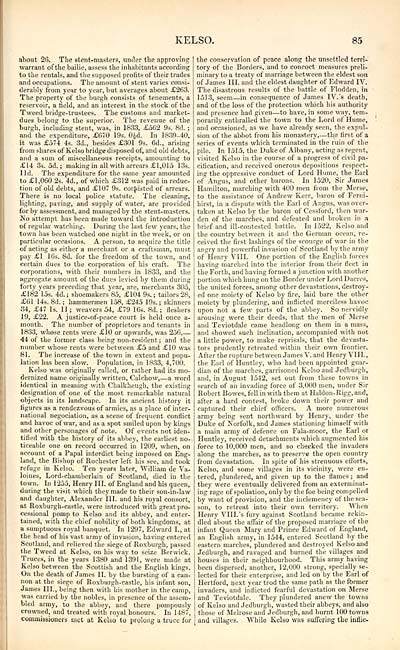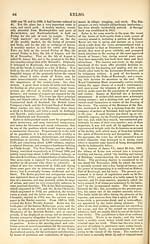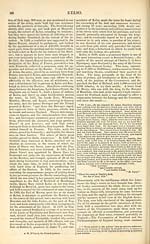Download files
Complete book:
Individual page:
Thumbnail gallery: Grid view | List view

KELSO.
85
about 26. The stent-masters, under the approving
warrant of the bailie, assess the inhabitants according
to the rentals, and the supposed profits of their trades
and occupations. The amount of stent varies consi-
derably from year to year, but averages about £263.
The property of the burgh consists of tenements, a
reservoir, a field, and an interest in the stock of the
Tweed bridge-trustees. The customs and market-
dues belong to the superior. The revenue of the
burgh, including stent, was, in 1S33, £562 9s. 8d. ;
and the expenditure, £670 19s. OJd. In 1839-40,
it was £574 4s. 3d., besides £301 9s. 6d., arising
from shares of Kelso bridge disposed of,- and old debts,
and a sum of miscellaneous receipts, amounting to
£14 3s. 5d. ; making in all with arrears £1,015 13s.
lid. The expenditure for the same year amounted
to £1,060 2s. id., of which £312 was paid in reduc-
tion of old debts, and £107 9s. consisted of arrears.
There is no local police statute. The cleaning,
lighting, paving, and supply of water, are provided
for by assessment, and managed by the stent-masters.
No attempt has been made toward the introduction
of regular watching. During the last few years, the
town has been watched one night in the week, or on
particular occasions. A person, to acquire the title
of acting as either a merchant or a craftsman, must
pay £1 16s. Sd. for the freedom of the town, and
certain dues to the corporation of his craft. The
corporations, with their numbers in 1833, and the
aggregate amount of the dues levied by them during
forty years preceding that year, are, merchants 305,
£182"l5s. 4d.; shoemakers 85, £104 9s. ; tailors 28,
£61 14s. Sd. ; hammermen 158, £245 19s.; skinners
34, £47 Is. 11 ; weavers 54, £79 16s. 8d. ; fleshers
19, £22. A justice-of-peace court is held once a-
month. The number of proprietors and tenants in
1833, whose rents were £10 or upwards, was 256, _
44 of the former class being non-resident ; and the
number whose rents were between £5 and £10 was
81. The increase of the town in extent and popu-
lation has been slow. Population, in 1833, 4,700.
Kelso was originally called, or rather had its mo-
dernized name originally written, Calchow, — a word
identical in meaning with Chalkheugh, the existing
designation of one of the most remarkable natural
objects in its landscape. In its ancient history it
figures as a rendezvous of armies, as a place of inter-
national negociation, as a scene of frequent conflict
and havoc of war, and as a spot smiled upon by kings
and other personages of note. Of events not iden-
tified with the history of its abbey, the earliest no-
ticeable one on record occurred in 1209, when, on
account of a Papal interdict being imposed on Eng-
land, the Bishop of Rochester left his see, and took
refuge in Kelso. Ten years later, William de A'a-
loines, Lord-chamberlain of Scotland, died in the
town. In 1255, Henry III. of England and his queen,
during the visit which they made to their son-in-law
and daughter, Alexander III. and his royal consort,
at Roxburgh-castle, were introduced with great pro-
cessional pomp to Kelso and its abbey, and enter-
tained, with the chief nobility of both kingdoms, at
a sumptuous royal banquet. In 1297, Edward I., at
the head of his vast army of invasion, having entered
Scotland, and relieved the siege of Roxburgh, passed
the Tweed at Kelso, on his way to seize Berwick.
Truces, in the years 1380 and 1391, were made at
Kelso between the Scottish and the English kings.
On the death of James II. by the bursting of a can-
non at the siege of Roxburgh-castle, his infant son,
James III., being then with his mother in the camp,
was carried by the nobles, in presence of the assem-
bled army, to the abbey, and there pompously
crowned, and treated with royal honours. In 1487,
commissioners met at Kelso to prolong a truce for
the conservation of peace along the unsettled terri-
tory of the Borders, and to concoct measures preli-
minary to a treaty of marriage between the eldest son
of James III. and the eldest daughter of Edward IV.
The disastrous results of the battle of Flodden, in
1513, seem — in consequence of James IV. 's death,
and of the loss of the protection which his authority
and presence had given — to have, in some way, tem-
porarily enthralled the town to the Lord of Hume,
and occasioned, as we have already seen, the expul-
sion of the abbot from his monastery, — the first of a
series of events which terminated in the ruin of the
pile. In 1515, the Duke of Albany, acting as regent,
visited Kelso in the course of a progress of civil pa-
cification, and received onerous depositions respect-
ing the oppressive conduct of Lord Hume, the Earl
of Angus, and other barons. In 1520, Sir James
Hamilton, marching with 400 men from the Merse,
to the assistance of Andrew Kerr, baron of Ferni-
hirst, in a dispute with the Earl of Angus, was over-
taken at Kelso by the baron of Cessford, then war-
den of the marches, and defeated and broken in a
brief and ill-contested battle. In 1522, Kelso and
the country between it and the German ocean, re-
ceived the first lashings of the scourge of war in the
angry and powerful invasion of Scotland by the army
of Henry VIII. One portion of the English forces
having marched into the interior from their fleet in
the Forth, and having formed a junction with another
portion which hung on the Border under Lord Dacres,
the united forces, among other devastations, destroy-
ed one moiety of Kelso by fire, laid bare the other
moiety by plundering, and inflicted merciless havoc
upon not a few parts of the abbey. So nervidly
arousing were their deeds, that the men of Merse
and Teviotdale came headlong on them in a mass,
and showed such inclination, accompanied with not
a little power, to make reprisals, that the devasta-
tors prudently retreated within their own frontier.
After the rupture between James V. and Henry VIII.,
the Earl of Huntley, who bad been appointed guar-
dian of the marches, garrisoned Kelso and Jedburgh,
and, in August 1542, set out from these towns in
search of an invading force of 3,000 men, under Sir
Robert Bowes, fell in with them at Haldon-Rigg, and,
after a hard contest, broke down their power and
captured their chief officers. A more numerous
army being sent northward by Henry, under the
Duke of Norfolk, and James stationing himself with
a main army of defence on Fala-moor, the Earl or
Huntley, received detachments which augmented his
force to 10,000 men, and so checked the invaders
along the marches, as to preserve the open country
from devastation. In spite of his strenuous efforts,
Kelso, and some villages in its vicinity, were en-
tered, plundered, and given up to the flames ; and
they were eventually delivered from an exterminat-
ing rage of spoliation, only by the foe being compelled
by want of provision, and the inclemency of the sea-
son, to retreat into their own territory. When
Henry VIII. 's fury against Scotland became rekin-
dled about the affair of the proposed marriage of the
infant Queen Mary and Prince Edward of England,
an English army, in 1544, entered Scotland by the
eastern marches, plundered and destroyed Kelso and
Jedburgh, and ravaged and burned the villages and
houses in their neighbourhood. This army having
been dispersed, another, 12,000 strong, specially se-
lected for their enterprise, and led on by the Earl of
Hertford, next year trod the same path as the former
invaders, and inflicted fearful devastation on Merse
and Teviotdale. They plundered anew the towns
of Kelso and Jedburgh, wasted their abbeys, and also
those of Melrose and Jedburgh, and burnt 100 towns
and villages. While Kelso was suffering the inflic-
85
about 26. The stent-masters, under the approving
warrant of the bailie, assess the inhabitants according
to the rentals, and the supposed profits of their trades
and occupations. The amount of stent varies consi-
derably from year to year, but averages about £263.
The property of the burgh consists of tenements, a
reservoir, a field, and an interest in the stock of the
Tweed bridge-trustees. The customs and market-
dues belong to the superior. The revenue of the
burgh, including stent, was, in 1S33, £562 9s. 8d. ;
and the expenditure, £670 19s. OJd. In 1839-40,
it was £574 4s. 3d., besides £301 9s. 6d., arising
from shares of Kelso bridge disposed of,- and old debts,
and a sum of miscellaneous receipts, amounting to
£14 3s. 5d. ; making in all with arrears £1,015 13s.
lid. The expenditure for the same year amounted
to £1,060 2s. id., of which £312 was paid in reduc-
tion of old debts, and £107 9s. consisted of arrears.
There is no local police statute. The cleaning,
lighting, paving, and supply of water, are provided
for by assessment, and managed by the stent-masters.
No attempt has been made toward the introduction
of regular watching. During the last few years, the
town has been watched one night in the week, or on
particular occasions. A person, to acquire the title
of acting as either a merchant or a craftsman, must
pay £1 16s. Sd. for the freedom of the town, and
certain dues to the corporation of his craft. The
corporations, with their numbers in 1833, and the
aggregate amount of the dues levied by them during
forty years preceding that year, are, merchants 305,
£182"l5s. 4d.; shoemakers 85, £104 9s. ; tailors 28,
£61 14s. Sd. ; hammermen 158, £245 19s.; skinners
34, £47 Is. 11 ; weavers 54, £79 16s. 8d. ; fleshers
19, £22. A justice-of-peace court is held once a-
month. The number of proprietors and tenants in
1833, whose rents were £10 or upwards, was 256, _
44 of the former class being non-resident ; and the
number whose rents were between £5 and £10 was
81. The increase of the town in extent and popu-
lation has been slow. Population, in 1833, 4,700.
Kelso was originally called, or rather had its mo-
dernized name originally written, Calchow, — a word
identical in meaning with Chalkheugh, the existing
designation of one of the most remarkable natural
objects in its landscape. In its ancient history it
figures as a rendezvous of armies, as a place of inter-
national negociation, as a scene of frequent conflict
and havoc of war, and as a spot smiled upon by kings
and other personages of note. Of events not iden-
tified with the history of its abbey, the earliest no-
ticeable one on record occurred in 1209, when, on
account of a Papal interdict being imposed on Eng-
land, the Bishop of Rochester left his see, and took
refuge in Kelso. Ten years later, William de A'a-
loines, Lord-chamberlain of Scotland, died in the
town. In 1255, Henry III. of England and his queen,
during the visit which they made to their son-in-law
and daughter, Alexander III. and his royal consort,
at Roxburgh-castle, were introduced with great pro-
cessional pomp to Kelso and its abbey, and enter-
tained, with the chief nobility of both kingdoms, at
a sumptuous royal banquet. In 1297, Edward I., at
the head of his vast army of invasion, having entered
Scotland, and relieved the siege of Roxburgh, passed
the Tweed at Kelso, on his way to seize Berwick.
Truces, in the years 1380 and 1391, were made at
Kelso between the Scottish and the English kings.
On the death of James II. by the bursting of a can-
non at the siege of Roxburgh-castle, his infant son,
James III., being then with his mother in the camp,
was carried by the nobles, in presence of the assem-
bled army, to the abbey, and there pompously
crowned, and treated with royal honours. In 1487,
commissioners met at Kelso to prolong a truce for
the conservation of peace along the unsettled terri-
tory of the Borders, and to concoct measures preli-
minary to a treaty of marriage between the eldest son
of James III. and the eldest daughter of Edward IV.
The disastrous results of the battle of Flodden, in
1513, seem — in consequence of James IV. 's death,
and of the loss of the protection which his authority
and presence had given — to have, in some way, tem-
porarily enthralled the town to the Lord of Hume,
and occasioned, as we have already seen, the expul-
sion of the abbot from his monastery, — the first of a
series of events which terminated in the ruin of the
pile. In 1515, the Duke of Albany, acting as regent,
visited Kelso in the course of a progress of civil pa-
cification, and received onerous depositions respect-
ing the oppressive conduct of Lord Hume, the Earl
of Angus, and other barons. In 1520, Sir James
Hamilton, marching with 400 men from the Merse,
to the assistance of Andrew Kerr, baron of Ferni-
hirst, in a dispute with the Earl of Angus, was over-
taken at Kelso by the baron of Cessford, then war-
den of the marches, and defeated and broken in a
brief and ill-contested battle. In 1522, Kelso and
the country between it and the German ocean, re-
ceived the first lashings of the scourge of war in the
angry and powerful invasion of Scotland by the army
of Henry VIII. One portion of the English forces
having marched into the interior from their fleet in
the Forth, and having formed a junction with another
portion which hung on the Border under Lord Dacres,
the united forces, among other devastations, destroy-
ed one moiety of Kelso by fire, laid bare the other
moiety by plundering, and inflicted merciless havoc
upon not a few parts of the abbey. So nervidly
arousing were their deeds, that the men of Merse
and Teviotdale came headlong on them in a mass,
and showed such inclination, accompanied with not
a little power, to make reprisals, that the devasta-
tors prudently retreated within their own frontier.
After the rupture between James V. and Henry VIII.,
the Earl of Huntley, who bad been appointed guar-
dian of the marches, garrisoned Kelso and Jedburgh,
and, in August 1542, set out from these towns in
search of an invading force of 3,000 men, under Sir
Robert Bowes, fell in with them at Haldon-Rigg, and,
after a hard contest, broke down their power and
captured their chief officers. A more numerous
army being sent northward by Henry, under the
Duke of Norfolk, and James stationing himself with
a main army of defence on Fala-moor, the Earl or
Huntley, received detachments which augmented his
force to 10,000 men, and so checked the invaders
along the marches, as to preserve the open country
from devastation. In spite of his strenuous efforts,
Kelso, and some villages in its vicinity, were en-
tered, plundered, and given up to the flames ; and
they were eventually delivered from an exterminat-
ing rage of spoliation, only by the foe being compelled
by want of provision, and the inclemency of the sea-
son, to retreat into their own territory. When
Henry VIII. 's fury against Scotland became rekin-
dled about the affair of the proposed marriage of the
infant Queen Mary and Prince Edward of England,
an English army, in 1544, entered Scotland by the
eastern marches, plundered and destroyed Kelso and
Jedburgh, and ravaged and burned the villages and
houses in their neighbourhood. This army having
been dispersed, another, 12,000 strong, specially se-
lected for their enterprise, and led on by the Earl of
Hertford, next year trod the same path as the former
invaders, and inflicted fearful devastation on Merse
and Teviotdale. They plundered anew the towns
of Kelso and Jedburgh, wasted their abbeys, and also
those of Melrose and Jedburgh, and burnt 100 towns
and villages. While Kelso was suffering the inflic-
Set display mode to: Large image | Transcription
Images and transcriptions on this page, including medium image downloads, may be used under the Creative Commons Attribution 4.0 International Licence unless otherwise stated. ![]()
| Gazetteers of Scotland, 1803-1901 > Topographical, statistical, and historical gazetteer of Scotland > Volume 2 > (97) Page 85 |
|---|
| Permanent URL | https://digital.nls.uk/97449754 |
|---|
| Description | Volume second: I-Z. |
|---|---|
| Shelfmark | Map Room Ref.2 |
| Attribution and copyright: |
|

